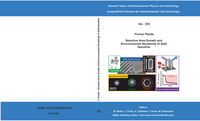
The three topics of this thesis deal with regard to the use of GaN nanostructures in electronic components. For a possible application of GaN nanostructures as transistors, their thermal behavior is of interest. Introductory measurements of the thermal properties of GaN nanostructures on different substrates show that the heat distribution on diamond is significantly colder and more uniform than on sapphire. These results motivate the first main topic block, the investigation of the selective growth of GaN nanostructures on diamond using molecular beam epitaxy. A special focus was placed on low-cost diamond substrates with a (001) surface. It is shown that the nanostructures grow uniformly, whereby the use of an AlN buffer layer increases their uniformity. The nanostructures nucleate in two different crystal domains, whereby the surface offcut angle of the diamond substrate is decisive for the preferential growth of one of these domains. Finally, it is shown that the nanostructures on the (001) surface nucleate exclusively gallium polar. Controlled and well-defined crystal facets are necessary for the integration of GaN nanostructures in electrical components. Therefore, the second main part of this thesis deals with the influence of the growth parameters during molecular beam epitaxy on the formation of their side facets. It is shown that the non-polar side facets of nanowires can be controlled by the nitrogen or gallium flux in such a way that either the a- or the m-plane facets are formed. A model is presented which is based on the locally available III-V supply during growth as a function of the molecular beam fluxes and the nanowire diameter. Furthermore, a different growth of GaN nanofins with a- and m-side facets is observed. A faster axial growth rate of the nanofins with a-plane side facets is a result of the anisotropic gallium diffusion at the non-polar facets. The last part of the thesis deals with the interaction of GaN nanostructures with their environment. The influence of adsorbates from the environment on the electrical and optical properties of GaN nanostructures is discussed. Water and oxygen reduce the conductivity of GaN nanofins. This effect can be enhanced by illumination and heat. Supplementary Kelvin potential measurements show that oxygen mainly increases the electronic surface band bending of GaN surfaces. In contrast, the adsorption of water is more complex, as surface dipoles also play a role here. An extension of the study regarding the influence of the environment on the optical properties of the nanostructures shows that oxygen in particular significantly influences the photoluminescence intensity of GaN depending on the temperature. The combination of simultaneous measurements of electrical conductivity and photoluminescence intensity indicates that oxygen mainly increases the surface band bending at low temperatures. This also occurs at higher temperatures, where an additional chemical surface termination can be observed. This shows that oxygen is subject to two fundamentally different adsorption mechanisms on GaN.